The Grand Order of Mugunghwa 무궁화대훈장
The Grand Order of Mugunghwa is the highest Order in the Republic of Korea. It is a single class order that is awarded to the President of the country and to foreign Heads of State. To many Koreans, the Grand Order of Mugunghwa is not as prestigious as it could be. This Order is self-awarded by the President and is not based on actual accomplishments other than winning a Presidential election. To many Koreans, it does not fit the principle of a modern democratic society, which does not recognize status and class. In general, Koreans feel that the Order of National Foundation is the most prestigious Korean Order.

In 1933, the Republic of China, under the leadership of Chiang Kai-shek 蔣中正, established the Grand Order of Brilliant Jade 采玉大勳章 (채옥대훈장), their highest decoration.1 It is “limited to the use of the head of state or bestowed upon the head of state of a friend”. The Korean Grand Order of Mugunghwa, which was established by Syngman Rhee in 1949, is used in a manner very similar to the Chinese Order of the Brilliant Jade. Considering Syngman Rhee’s involvement in the Korean Provisional Government and its relationship to the Republic of China, it is not too hard to see where Syngman Rhee got his inspiration for the Grand Order of Mugunghwa. Add to this Syngman Rhee’s life-long obsession with self-aggrandizement, and the connections become more apparent. There is one primary difference between the Grand Order of Mugunghwa and the original Order of the Brilliant Jade. The original 1933 Chinese Order was divided into the Grand Order of Brilliant Jade (still currently used) and the Order of Brilliant Jade, with nine classes. On Feb. 12, 1941, the Chinese Nationalist Government discontinued the Order of Brilliant Jade in nine classes, due to the complexity of the Order and because of the production costs. At the time, there was a shortage of agate.
The first Grand Order of Mugunghwa was awarded to Korea’s 1st President Syngman Rhee at a National Foundation Ceremony held at the Central Office on August 15, 1949. The first medal awarded to a foreign Head of State was to West German President Heinrich Lübke on December 8, 1964 . The first, First Lady of the Republic of Korea to be awarded the Grand Order of Mugunghwa was Yuk Young-soo, wife of President Park Chung-hee . Francesca Donner, wife of President Syngman Rhee, and Gong Deok-gwi 공덕귀 (孔德貴), the wife of President Yoon Bo-seon , was not awarded the Grand Order of Mugunghwa because there was no award to spouses during their administrations. Syngman Rhee, donated his Grand Order of Mugunghwa and his Order of National Foundation to his Alma Mater. He had received an AB in 1907 from George Washington University, his BA at Harvard University and his PhD at Princeton University. It is unclear as to which Alma Mater has the medal. President Park Chung-hee received the Grand Order of Mugunghwa on the day of his inauguration, Dec. 17, 1963.2 Since then, all Korean Presidents have received their Grand Order of Mugunghwa on the day of their inauguration. The only exception to that was President Roh Moo-Hyun who decided to receive his from the incoming president upon his departure from the office.
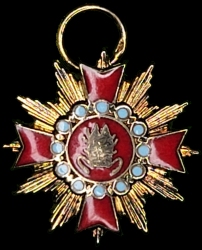
From the 4th President Yoon Bo-sun, the Grand Order of Mugunghwa was awarded at the presidential inauguration ceremony. For the 13th President, Roh Tae-woo, the medal was not worn at the inauguration ceremony. It has become customary for successive presidents to receive the Grand Order of Mugunghwa at the Blue House as the first official event after the inauguration ceremony. The government had decided to authorize the award to the president-elect during a cabinet meeting so that the new president would receive the medal upon inauguration. At Chun Doo-hwan’s last cabinet meeting, held on February 24, 1988, it was voted to award the order to the 13th President-elect Roh Tae-woo and his wife Kim Ok -sook. At another cabinet meeting held on February 11, 1993, the Roh Tae-woo administration decided to award the 14th President-elect Kim Young-sam and his wife, Son Myung-soon. They received the Order from the Minister of Internal Affairs and Communications. The Kim Young-sam government decided to confer the medals on the 15th President-elect Kim Dae-jung and his wife Lee Hee-ho at a cabinet meeting held on February 17, 1998 . They also received their awards from the Minister of Internal Affairs and Communications. The 16th President Roh Moo-hyun refused to receive the medal when he was elected, saying that it would be more appropriate to receive it when he retires from office, after being evaluated for merits and demerits during his term of office, rather than at the beginning of his administration. The 17th President, Lee Myung-bak, also declined the medal, citing the global economic crisis, at the beginning of his inauguration, but on February 12, 2013, right before his retirement, his cabinet decided to award the Order. At the last cabinet meeting held on February 19, 2013, the Lee Myung-bak administration decided to award the medal to the 18th President-elect, Park Geun-hye .
Even if a former president is stripped of his medals, it appears that it is impossible to revoke the Grand Order of Mugunghwa. For example, former Korean presidents: Chun Doo-hwan and Roh Tae-woo, had nine and eleven medals, respectively, revoked at a 2006 State Council meeting, because of their connection with the December 12 Military Coup and the suppression of the May 18 Pro-Democracy Movement.3 However, they were allowed to keep their Grand Orders of Mugunghwa. The Grand Order of Mugunghwa was excluded from cancellation because of legal issues that would deny their legality of their presidencies altogether. In the case of former President Park Geun-hye, who was removed from office and imprisoned for corruption, she received the Grand Order of Mugunghwa, before taking office, and has not been required to relinquish it. There is a gray area in the law. It was customary for the out-going president’s cabinet to give the award to the president-elect. The question becomes, “Can you take away a former president’s Grand Order of Mugunghwa if the former president is convicted of malfeasance in office, who wasn’t actually in the office at the time that they received the Order?”.
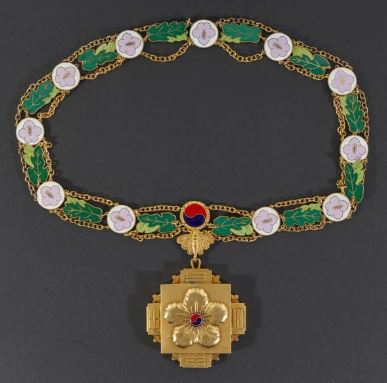
1949 SERIES
The Grand Order of Mugunghwa was created on Aug. 15, 1949 by Presidential Decree #164. The original design for the Grand Order of Mugunghwa was used from 1949 to 1967. It consisted of a collar only. The arrangement of the bars around the pendant and the Taeguk in the center represent the Korean Nation Flag. The Mugunghwa flower on the pendant symbolizes national prosperity. The square portion represents the solid foundation of Korea. The Mugunghwa flowers found along the length of the chain symbolize the provinces of Korea, which includes the special cities, like Seoul, that have provincial status. The butterfly suspension symbolizes the liberation of the country and the founding of the Republic of Korea. The pendant is relatively large. It is described as 87 mm, with the Mugunghwa flower being 58 mm across and the Taeguk symbol having a diameter of 10 mm. The Order is primarily made of gold. In the chain, the light green leaves are 37 mm in length, while the light purple Mugunghwa flowers are 13 mm. Silver is used to accent the flowers along the length of the chain. The taeguk symbol found connecting the chain to the suspension is 20 mm. The legislation gives no dimensions for the butterfly suspension, nor any indication of the weight. Variations are known to exist.
The example at right of the 1949 Series of the Grand Order of Mugunghwa was issued to Karl Heinrich Lübke (1894 – 1972) who was the second President of the Federal Republic of Germany (West Germany) from 1959 to 1969. He was the first European head of state to visit Korea. Some information sources on the internet, indicate that his wife, Wilhelmine Lübke was also decorated, but at the time, there was no award given to spouses. Her biography does not list any Korean Awards. At the same time, Karl Lübke’s biographies quite often do not list his Korean award.
Technically, the Order of the Grand Order of Mugunghwa was abolished on March 24, 1964.4
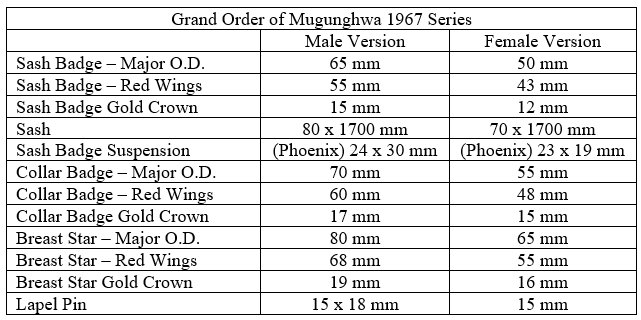
1967 SERIES
On Jan. 28, 1967, the first Decorations Law Enforcement Decree #2929 was enacted. It technically resurrected the Grand Order of Mugunghwa and made a complete design change for the order. This series consists of: a chain, a grand cordon (Sash) with pendant, a breast star and a lapel pin. Like the original series, it is awarded to the President of the Republic of Korea and to foreign Heads of State, but beginning with this legislation, presidential spouses are also eligible. The Korean Government established smaller sizes for the male or female spouse. These smaller (spousal) sizes are manufactured in silver rather than gold. The Grand Order of Mugunghwa is the only Korean order where the sash is worn over the left shoulder. There are several websites which purport to show a ribbon bar for the Grand Order of Mugungwha, but there is no provision in the Korean legislation for a ribbon bar.
The two phoenixes and the Mugunghwa flower, found on the suspension, are the Presidential Seal. The sun’s rays symbolize the heightened dignity of the country. The scarlet red color within the circle symbolizes enthusiasm and combative spirit, while the scarlet red on the wings symbolizes the brilliance of the hard work. The purple pearls symbolize the fruitage of the hard work. The golden crown represents the highest position. The dotted circle denotes the unity of the nation. The Mugunghwa flowers found along the length of the chain represent the administrative districts of the country. The butterflies hidden within the filigree of the chain represent a lucky omen. The Taeguk symbolizes the Republic of Korea, while the laurel crown denotes peace and freedom. The manufacturing cost is approx. 50 million won for men as of December 2016, and 35 million won for the women’s smaller size. The Order contains gold, silver, rubies, amethyst, and silk.

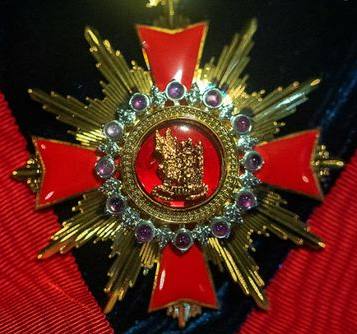

1984 SERIES
In the 1984 revision, changes were made to the Grand Order of Mugunghwa. The Korean government continued to issue both a Male and Female gold versions, but they also added both Male and Female versions in silver for the spouses. The dimensions within this legislation have changed, but not significantly. A single decimal point has been added to the dimensional data. For example, the dimension for the Sash Badge – Red Wings in the earlier legislation was 55 mm, it is now 55.7 mm. Appearance wise, there is no discernible difference.
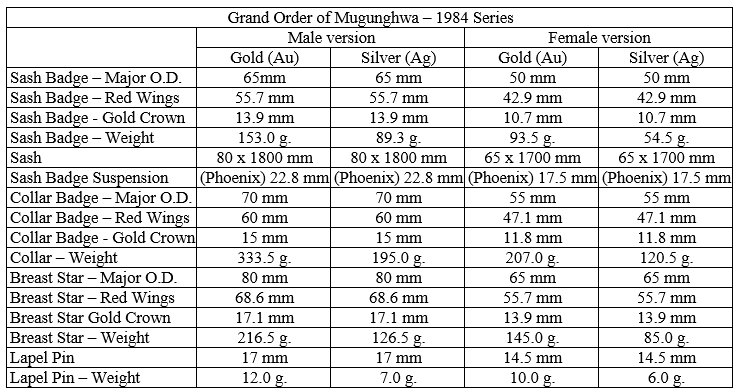
CURRENTLY
Since 1967, the Decorations Law Enforcement Decree has been changed 29 times. The current legislation is Presidential Decree #30517 and was enacted on March 10, 2020. In the intervening years, the only major change was to the Grand Order of Mugunghwa, (sized) for Ladies. It was found to be discriminatory and was dropped in 2016.5 There have been some minor changes. On Jun. 30, 1971, for the male version, the phoenix suspension on the sash badge was enlarged to 24 × 35 mm from 24 × 30 mm. All the basic sizes, patterns, etc., of the 1967 legislation, are still in effect.
Award Recipients of the Grand Order of Mugunghwa (Click Here for the information source.)
| Year | Name | Title | Nationality |
|---|---|---|---|
| 1949 | Syngman Rhee | President | Republic of Korea |
| 1960 | Yun Posun | President | Republic of Korea |
| 1963 | Park Chung-hee | President | Republic of Korea |
| 1964 | Heinrich Lübke | President | West Germany |
| 1966 | Ismail Nasiruddin of Terengganu | King | Malaysia |
| Tengku Ampuan Tua Intan Zaharah | Queen | ||
| Bhumibol Adulyadej | King | Thailand | |
| Sirikit | Queen | ||
| Chiang Kai-shek | President | China | |
| 1967 | Yuk Young-soo | First lady | Republic of Korea |
| 1968 | Haile Selassie | Emperor | Ethiopia |
| 1969 | Nguyễn Văn Thiệu | President | South Vietnam |
| Nguyễn Thị Mai Anh | First lady | ||
| Hamani Diori | President | Niger | |
| Aissa Diori | First lady | ||
| 1970 | Fidel Sánchez Hernández | President | El Salvador |
| Marie Nade Sánchez Hernández | First lady | ||
| 1975 | Omar Bongo | President | Gabon |
| Josephine Bongo | First lady | ||
| 1979 | Léopold Sédar Senghor | President | Senegal |
| Colette Hubert Senghor | First lady | ||
| Choi Kyu-hah | President | Republic of Korea | |
| Hong Gi | First lady | ||
| 1980 | Khalid of Saudi Arabia | King | Saudi Arabia |
| Jaber Al-Ahmad Al-Sabah | Emir | Kuwait | |
| Chun Doo-hwan | President | Republic of Korea | |
| Rhee Soon-ja | First lady | ||
| 1981 | Suharto | President | Indonesia |
| Siti Hartinah | First lady | ||
| Ahmad Shah of Pahang | King | Malaysia | |
| Tengku Ampuan Afzan | Queen | ||
| Ferdinand Marcos | President | Philippines | |
| Imelda Marcos | First lady | ||
| Rodrigo Carazo Odio | President | Costa Rica | |
| Estrella Zeledón Lizano | First lady | ||
| 1982 | Samuel Doe | President | Liberia |
| Mobutu Sese Seko | President | Democratic Republic of the Congo | |
| Bobi Ladawa Mobutu | First lady | ||
| Abdou Diouf | President | Senegal | |
| Kenan Evren | President | Turkey | |
| 1983 | Gaafar Nimeiry | President | Sudan |
| Butina Khalil Abbulhashan | First lady | ||
| Hussein of Jordan | King | Jordan | |
| Queen Noor of Jordan | Queen | ||
| 1984 | Hassanal Bolkiah | Sultan | Brunei |
| Khalifa bin Hamad Al Thani | Emir | Qatar | |
| Dawda Jawara | President | Gambia | |
| Chilele Jawara | First lady | ||
| Maumoon Abdul Gayoom | President | Maldives | |
| 1985 | Muhammad Zia-ul-Haq | President | Pakistan |
| Luis Alberto Monge | President | Costa Rica | |
| 1986 | Elizabeth II | Queen | United Kingdom |
| Baudouin of Belgium | King | Belgium | |
| 1987 | Ahmed Abdallah | President | Comoros |
| 1988 | Roh Tae-woo | President | Republic of Korea |
| Kim Ok-suk | First lady | ||
| Iskandar of Johor | King | Malaysia | |
| Tunku Puan Zanariah | Queen | ||
| 1989 | Richard von Weizsäcker | President | West Germany |
| François Mitterrand | President | France | |
| Danielle Mitterrand | First lady | ||
| 1990 | Andrés Rodríguez | President | Paraguay |
| Árpád Göncz | President | Hungary | |
| 1991 | Azlan Shah of Perak | King | Malaysia |
| Raja Permaisuri Bainun | Queen | ||
| Carlos Salinas de Gortari | President | Mexico | |
| 1992 | Jorge Serrano Elías | President | Guatemala |
| 1993 | Kim Young-sam | President | Republic of Korea |
| Son Myung-soon | First lady | ||
| Fidel Ramos | President | Philippines | |
| Amelita Ramos | First lady | ||
| 1994 | Eduardo Frei Ruiz-Tagle | President | Chile |
| Lech Wałęsa | President | Poland | |
| 1995 | Islam Karimov | President | Uzbekistan |
| Roman Herzog | President | Germany | |
| Zhelyu Zhelev | President | Bulgaria | |
| Nelson Mandela | President | South Africa | |
| Carlos Menem | President | Argentina | |
| 1996 | Álvaro Arzú | President | Guatemala |
| Fernando Henrique Cardoso | President | Brazil | |
| Juan Carlos I of Spain | King | Spain | |
| Queen Sofía of Spain | Queen | ||
| Tuanku Ja’afar | King | Malaysia | |
| Leonid Kuchma | President | Ukraine | |
| 1998 | Kim Dae-jung | President | Republic of Korea |
| Lee Hee-ho | First lady | ||
| 2000 | Carlo Azeglio Ciampi | President | Italy |
| Jacques Chirac | President | France | |
| 2006 | Abdelaziz Bouteflika | President | Algeria |
| 2007 | Sabah Al-Ahmad Al-Jaber Al-Sabah | Emir | Kuwait |
| Hamad bin Khalifa Al Thani | Emir | Qatar | |
| 2008 | Roh Moo-hyun | President | Republic of Korea |
| Kwon Yang-sook | First lady | ||
| 2009 | Nursultan Nazarbayev | President | Kazakhstan |
| Alan García | President | Peru | |
| Giorgio Napolitano | President | Italy | |
| 2011 | Margrethe II of Denmark | Queen | Denmark |
| 2012 | Carl XVI Gustaf of Sweden | King | Sweden |
| Khalifa bin Zayed Al Nahyan | President | United Arab Emirates | |
| 2013 | Lee Myung-bak | President | Republic of Korea |
| Kim Yoon-ok | First lady | ||
| Park Geun-hye | President | Republic of Korea | |
| 2014 | Susilo Bambang Yudhoyono | President | Indonesia |
| 2015 | Ollanta Humala | President | Peru |
| 2017 | Moon Jae-in | President | Republic of Korea |
| Kim Jung-sook | First lady | ||
| 2019 | Harald V | King | Norway |
| 2021 | Alexander Van der Bellen | President | Austria |
| Felipe VI de Borbon y Grecia | King | Spain | |
| Letizia Ortiz | Queen | ||
| Iván Duque Márquez | President | Colombia | |
| Borut Pahor | President | Slovenia | |
| 2022 | Moon Jae-in | President | Republic of Korea |
| Kim Jung-sook | First Lady | ||
| 2023 | Andrzej Duda | President | Poland |
Footnotes:
- Officially, the name ‘Brilliant Jade’ comes from the tradition of honoring jade as the jewel of a gentleman. The meaning was taken from the Book of Poetry 詩經 (시경) also known as the Book of Songs. In it, there is a poetic phrase ‘Thinking of a gentleman, his gentleness is like jade (言念君子•溫其如玉)’. The Book of Poetry is the oldest existing collection of Chinese poetry, dating from the 11th to 7th centuries BCE. However, there is a widespread belief that the Order was actually named after Chiang Kai-shek’s mother 王采玉.
- Korean Report, Volume Three, Number Eight, Dec. 1963, pp.4, 15, 16
- The military coup of December 12, 1979, put Chun Doo-hwan in the presidency, is known in Korea as the 12.12 Military Rebellion, 12.12 군사반란 (12.12 軍事叛亂). The May 18 Pro-Democracy Movement, is better known in Korea as 5·18 (May 18; 오일팔 (五一八) which is a reference to the date that the movement began. The uprising is also known as the Kwangju Democratization Struggle 광주 민주화 항쟁 (光州民主化抗爭), better known in the West as the Kwangju Massacre.
- The Grand Order of Mugunghwa Decree 무궁화대훈장령 Presidential Decree #1741 [대통령령 제1741호, 1964. 3. 24., Abolition 폐지].
- Decorations Law Enforcement Decree 상훈법 시행령, Presidential Decree #26838 대통령령 제26838호, dated 2015.12.31 and implemented on 2016.1.1.[시행 2016.1.1.], partial revision 일부개정.
